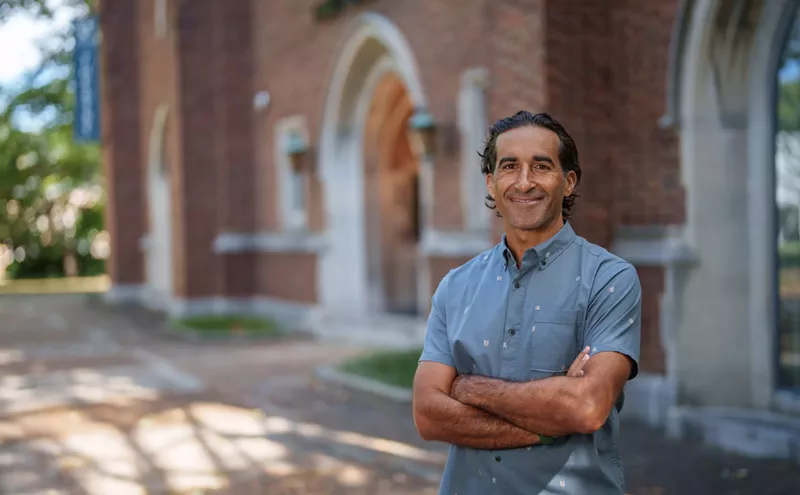"Tamayo: A Modern Icon Reinterpreted" marks his first major U.S. exhibition in nearly 30 years, and features close to 100 paintings culled from private and institutional collections from across the globe. Many of Tamayo's captivating paintings at MAM have not been publicly displayed for decades.
The gorgeous show unfolds chronologically, beginning with a small group of works from the Twenties in which Tamayo first dabbled with early French Modernism. From there it jumps to an expansive survey of his iconic mature works from the Forties and Fifties, during which he developed his unique style of figurative abstraction. This era comprises the bulk of the show, which culminates with a modest yet striking selection from his late production.
Exploring 70 years of Tamayo's prolific career, the traveling exhibition was curated by Diana C. du Pont, curator of modern and contemporary art at the Santa Barbara Museum of Art; and Juan Carlos Pereda, curator of Mexico City's Museo Tamayo Arte Contemporáneo.
The show is less a retrospective than a re-examination of Tamayo's oeuvre and the artist's enduring impact on the contemporary scene. "Tamayo's international perspective and aesthetic approach serve as an example for the contemporary Mexican artist working globally," explains du Pont. "In many ways Tamayo had and continues to have a significant influence, which this exhibition seeks to understand."
A brilliantly illustrated and researched 450-page catalogue has been produced for the exhibit, and informative wall texts and handouts effectively bring to life Tamayo the artist and the man.
He was born August 25, 1899, in Oaxaca, Mexico, and moved to Mexico City when his mother died in 1911. He enrolled in Escuela Nacional de Bellas Artes in 1917. As a young artist, Tamayo experimented with Impressionism, Fauvism, Cubism, and other European art movements of the period, but through an innately Mexican prism.
Following the Mexican Revolution, which lasted from 1910 to 1921, Tamayo was among those devoted to exploring national identity in their work. His pieces reflected native influences and the social and political concerns of the era.
Because he eschewed the politically charged Social Realism popularized by the lionized Mexican muralists -- José Clemente Orozco, Diego Rivera, and David Alfaro Siqueiros, known as Los Tres Grandes (The Three Greats) -- Tamayo was disdained as a traitor to the cause. He left for New York in 1926, eager to express himself more freely.
But before his departure, he organized his own solo show in Mexico City, where he was recognized as an emerging talent whose vision offered a fresh counterpoint to the nationally dominant call for art of a political nature.
His first show in New York was a resounding success, and he soon became a fixture among the city's art establishment, which was seduced by Tamayo's "Indian" roots and avant-garde primitivism.
Returning to Mexico in 1929, he had a solo show at Galería de Arte Moderno that drew large crowds and received massive press coverage. It also ignited a heated debate in which some praised Tamayo for rubbing against the muralists' grain, while others flayed him for his lack of revolutionary fervor.
He lived in New York with his wife Olga from 1937 to 1949, creating what many consider his greatest works and earning a place in the history books. An international star, he was honored by his homeland with his first major retrospective, in 1948 at the Palacio de Bellas Artes in Mexico City, where Tamayo once again found himself in the crosshairs over the role of art in Mexican society.
As a result, Tamayo, Orozco, Rivera, and Siqueiros ended up duking out their differences in the leading Mexican and U.S. newspapers and magazines, widening the controversy. But in 1950, when Tamayo and his other Tres Grandes compatriots became the first Mexican artists to be included in the Venice Biennale, he was the one who stole the international thunder.
He and Olga moved to Paris in 1949 and were embraced by the European artistic and intellectual elite.
Returning permanently to Mexico after a decade in Paris, the already consecrated master still found himself dogged by arguments. Those mired by socially fueled narrative painting squabbled endlessly with the artist for selling out with his abstract, international style.
At one point, a reconciliation seemed in the works when Tamayo was dubbed "The Fourth Great One," an appellation he bristled at. But many believe the honor came a little too late, and that detractors would begrudge the artist for being the prick who let the air out of Los Tres Grandes' balloon.
It might be in this regard that MAM's exhibit best reflects Tamayo's tapping the creative potential of Mexican culture.
Observing signature works from his mature period, created in New York during the Forties, one is struck by Tamayo's arresting ability to dynamically portray the gamut of human emotion with profoundly universal appeal.
The terror of World War II and the fear of global destruction that followed appear in 1947's Niña Atacada por un Pajaro Extrano (Girl Attacked by a Strange Bird) and 1949's El Atormentado (The Tormented Man).
In the first painting, a naive, childlike figure flails her arms as a predatory black and blue jay menacingly dives at her throat. The bird seems frozen against a sickly, dirty green sky, adding to the work's deceptively ominous air. Tamayo saw the swooping bird as a metaphor for the bombers darkening the skies during the war.
In the second piece, Tamayo has placed a solitary screaming figure in the center of lurid yellow, orange, and red spiked flames as if in the bowels of Dante's inferno stoked by the furnace of a nuclear nightmare.
One of his most humorous works, 1953's Discusión Acalorada (Heated Discussion), depicts Tamayo and Siqueiros in one of their patented tiffs -- famously among the most incendiary in all modern art. The red and burnt orange figures are barely discernible, but Tamayo makes his adversary evident by incorporating a reference to Siqueiro's eye, lifted from one of the muralist's self-portraits from 1939.
La Perla (The Pearl) (1950) is a stunning example of Tamayo's mastery of color. It features a mother sitting alongside her child, cupping a pearl in her hand. The painting's lavish pink, orange, and gray hues cast a rich glow off one of MAM's walls.
Nobel Prize-winning poet Octavio Paz, who wrote many essays about Tamayo's work, once observed, "If I could express with a single word what it is that distinguishes Tamayo from other painters, I would say without a moment's hesitation: sun. For the sun is in all his pictures, whether we see it or not."
This sprawling window onto the remarkable world of Tamayo's work offers too much to ingest in one day. It not only casts new light on the artist's career, but also accomplishes it in a way that invites viewers to return to the source of the heat again and again.












